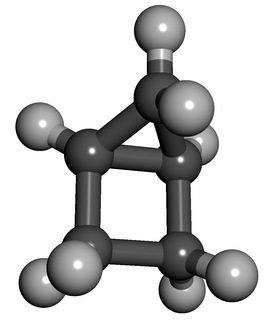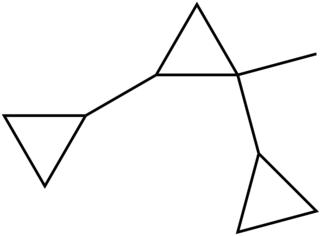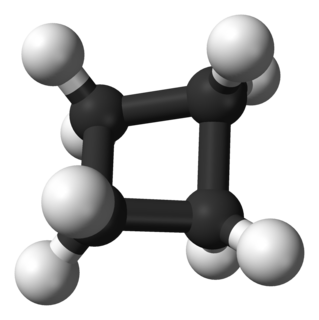
An alicyclic compound is an organic compound that is both aliphatic and cyclic. They contain one or more all-carbon rings which may be either saturated or unsaturated, but do not have aromatic character. Alicyclic compounds may have one or more aliphatic side chains attached.
In organic chemistry, a homologous series is a series of compounds with the same functional group and similar chemical properties in which the members of the series differ by the number of repeating units they contain. This can be the length of a carbon chain, for example in the straight-chained alkanes (paraffins), or it could be the number of monomers in a homopolymer such as amylose.

In organic chemistry, ring strain is a type of instability that exists when bonds in a molecule form angles that are abnormal. Strain is most commonly discussed for small rings such as cyclopropanes and cyclobutanes, whose internal angles are substantially smaller than the idealized value of approximately 109°. Because of their high strain, the heat of combustion for these small rings is elevated.

In organic chemistry, a bent bond, also known as a banana bond, is a type of covalent chemical bond with a geometry somewhat reminiscent of a banana. The term itself is a general representation of electron density or configuration resembling a similar "bent" structure within small ring molecules, such as cyclopropane (C3H6) or as a representation of double or triple bonds within a compound that is an alternative to the sigma and pi bond model.

A spiro compound, or spirane, from the Latin spīra, meaning a twist or coil, is a chemical compound, typically an organic compound, that presents a twisted structure of two or more rings, in which 2 or 3 rings are linked together by one common atom, examples of which are shown at right.

Cyclopropanation refers to any chemical process which generates cyclopropane rings. It is an important process in modern chemistry as many useful compounds bear this motif; for example pyrethroids and a number of quinolone antibiotics. However the high ring strain present in cyclopropanes makes them challenging to produce and generally requires the use of highly reactive species, such as carbenes, ylids and carbanions. Many of the reactions proceed in a cheletropic manner.

A fenestrane in organic chemistry is a type of chemical compound with a central quaternary carbon atom which serves as a common vertex for four fused carbocycles. They can be regarded as spiro compounds twice over. Because of their inherent strain and instability, fenestranes are of theoretical interest to chemists. The name—proposed in 1972 by Vlasios Georgian and Martin Saltzman—is derived from the Latin word for window, fenestra. Georgian had intended that "fenestrane" solely referred to [4.4.4.4]fenestrane, whose skeletal structure looks like windows, and Kenneth B. Wiberg called that specific structure "windowpane". The term fenestrane has since become generalized to refer to the whole class of molecules that have various other ring-sizes. Georgian recommended rosettane for the class, based on the structural appearance as a rosette of flowers.
Malvalic acid is a cyclopropene fatty acid found in baobab seed oil and cottonseed oil. The cyclopropene ring is thought to be one of the causes of abnormalities that develop in animals that ingest cottonseed oil. Refining processes, such as hydrogenation, oil can remove or destroy malvalic acid.

Housane or bicyclo[2.1.0]pentane is a saturated cycloalkane with the formula C5H8. It is a colorless volatile liquid at room temperature. It was named "housane" because of its shape. Structurally, the molecule consists of cyclopropane fused to cyclobutane. The synthesis of molecules containing multiple strained rings, such as housane, is a traditional endeavor in synthetic organic chemistry. This compound is prepared in several steps starting with cyclopentadiene.
FLEX Records is a Danish record label. Label founded by Scandinavian Records in 1994 to release various electronic music. It was sold to the Danish branch of the EMI group in 1996.

Syntin is a hydrocarbon with the molecular formula C10H16 used as a rocket fuel. It is a mixture of four stereoisomers (see below). It has a density of 0.851 g/mL, and a boiling point of 158 °C. Due to the presence of three strained cyclopropane rings, the molecule has high positive enthalpy of formation: ΔfH°(l)= 133 kJ/mol (980 kJ/kg, the average value for the isomeric mixture), bringing additional energy during the combustion process. Thus, it has advantages over the traditional hydrocarbon fuels, such as RP-1, due to higher density, lower viscosity and higher specific heat of oxidation.

1,2-Dimethylcyclopropane is a cycloalkane consisting of a cyclopropane ring substituted with two methyl groups attached to adjacent carbon atoms. It has three stereoisomers, one cis-isomer and a pair of trans-enantiomers, which differ depending on the orientation of the two methyl groups. As with other cyclopropanes, ring tension results in a relatively unstable compound.
The Buchner ring expansion is a two-step organic C-C bond forming reaction used to access 7-membered rings. The first step involves formation of a carbene from ethyl diazoacetate, which cyclopropanates an aromatic ring. The ring expansion occurs in the second step, with an electrocyclic reaction opening the cyclopropane ring to form the 7-membered ring.
Cyclopropyl cyanide is an organic compound consisting of a nitrile group as a substituent on a cyclopropane ring. It is the smallest cyclic compound containing a nitrile.

Flumethrin is a pyrethroid insecticide. It is used externally in veterinary medicine against parasitic insects and ticks on cattle, sheep, goats, horses, and dogs, and the treatment of parasitic mites in honeybee colonies.

Bicyclobutane is an organic compound with the formula C4H6. It is a bicyclic molecule consisting of two cis-fused cyclopropane rings, and is a colorless and easily condensed gas. Bicyclobutane is noted for being one of the most strained compounds that is isolatable on a large scale – its strain energy is estimated at 63.9 kcal mol−1. It is a nonplanar molecule, with a dihedral angle between the two cyclopropane rings of 123°.
A descriptor is in chemical nomenclature a prefix placed before the systematic substance name, which describes the configuration or the stereochemistry of the molecule. Some listed descriptors are only of historical interest and should not be used in publications anymore as they do not correspond with the modern recommendations of the IUPAC. Stereodescriptors are often used in combination with locants to clearly identify a chemical structure unambiguously.
![[4]Rotane consists of a cyclobutane core, with a spiro-cyclopropane on each corner of it 4-Rotane.png](http://upload.wikimedia.org/wikipedia/commons/thumb/b/bd/4-Rotane.png/220px-4-Rotane.png)














